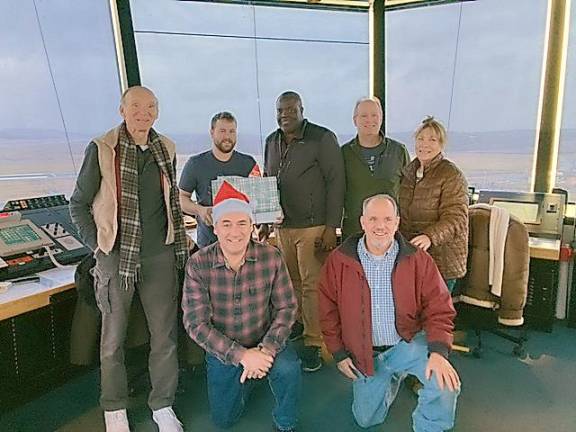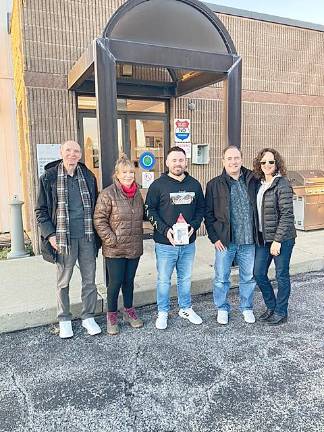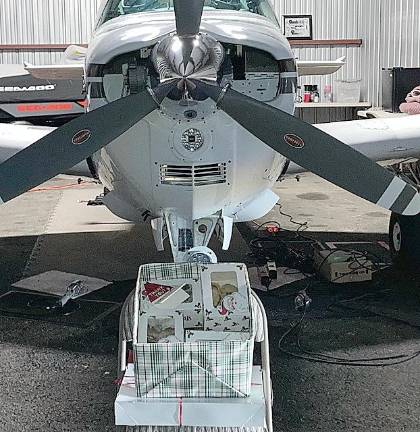Treats for air controllers
Orange County. Orange County Pilots Association members brought “Treats for the Towers”--air controllers whose guidance they learned to discern.



Hans Pittner was happy to join other pilots from the Orange County Pilots Association (OCPA) bringing “Treats for the Towers” on December 11th. They bore boxes of homemade holiday goodies for air controllers operating out of nearby Stewart Airport and the Hudson Valley Regional Airport.
A Certified Flight Instructor at Orange County’s KMGJ airport in Montgomery, he says he flies in and out of these facilities many times during the year, sometimes practicing “approaches”— instructions that need to be followed to land on certain runways. He also lets students experience what it’s like to talk to the controllers in the towers overlooking the field.
“Air space is a difficult concept,” he says. “It’s hard to describe and, especially for beginning pilots, a challenge to navigate and comprehend.” He explains that while you can take off from “uncontrolled” airports—those without towers and controllers, you can’t fly into controlled air space without first tuning in a specific radio frequency and asking a controller for permission.
“Talking on the radio to an air controller can be intimidating,” he said. “Not only do they seem to have a language all their own...they’re often speaking one at a time to a number of other pilots, sometimes sounding like they’re addressing them all at once.” Pilots have to learn to get a word in edgewise--speaking requests without interrupting communications with other pilots. More hair raising is the fact that controllers may talk to pilots in a small, “general aviation” aircraft on the same radio frequency they use to reach crews on airplanes the size of a 747.
“Controllers at neighboring airports often take time to help a student pilot get it right. They may speak to them more slowly,” he said.
You might say that pilots at Orange County Airport (KMGJ) in Montgomery are lucky. KMGJ is an “uncontrolled” airport. Without controllers on the field to direct traffic, pilots can take off, land, taxi their aircraft or hold short and wait for other aircraft all on their own. “They typically use the radio frequency assigned to KMGJ to communicate with other pilots, but they’re not legally required to do so,” he says.
Eventually most pilots from uncontrolled airports will want to spread their wings and explore new horizons. When they do, chances are that they’ll need to make contact with air traffic controllers. That’s when they find out that air controllers aren’t a threat. Their job is to help keep pilots safe. They may direct or “clear” them on their way after they’ve filed a specific route or “flight plan” in advance.
Air controllers are also on the lookout to let them know if they need to change their course to get out of the way of other aircraft in the vicinity. When pilots become proficient enough to earn an advanced rating and fly by solely looking at their instruments—in the clouds for example—controllers stay in contact with them. In an emergency, air controllers can direct pilots to safety. In short, air controllers can save many pilots lives and they frequently do.
When the weather is bad and visibility is diminished, pilots trying to land at an uncontrolled airport like KMGJ will prefer to “divert” or go to a nearby airport like KSWF where runways are long enough to accommodate military aircraft and commercial jets. There are also other welcoming amenities...like advanced lighting systems built into the runway to point the way. “But the most important thing by far is having the reassuring voice of an air controller, talking to you as you make your way down to the point where the runway comes into view,” he says. “That’s priceless.”
For reasons like these, pilots from KMGJ wanted to say thanks to their neighboring controllers for all their help throughout the year. When they arrived at the airports with cookies onboard, the pilots themselves got a treat—they were invited to get a glimpse of what goes on in those towers—and to finally put a face to some of the voices they’ve come to know only on the radio--reassuring voices that can break a silent night—and maybe even save a life when they do.
Talking on the radio to an air controller can be intimidating. Not only do they seem to have a language all their own...they’re often speaking one at a time to a number of other pilots, sometimes sounding like they’re addressing them all at once. - Hans Pittner, Orange County Pilots Association member